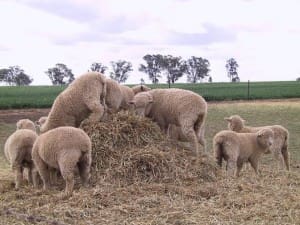Sheep producers are increasingly using silage to fill pasture feed gaps, and especially when grain prices are high.
And some farmers are finding silage also has grass seed and climatic risk management benefits for sheep operations.
But Western District Grassland Society branch president Dr Steve Cotton said while many dairy farmers were good at making silage, beef and sheep farmers were less successful.
Average sheep farmer silage samples sub-optimal
“Samples we receive from dairy clients are typically very good, but what the average sheep and beef farmer produces is usually sub-optimal,” Dr Cotton, from Hamilton-based Livestock Logic said.
Dr Cotton said farmers needed to concentrate on quality over quantity and get their timing right.
“People get bogged down in waiting for their pasture to produce a lot more dry matter before they cut it,” he said.
“They should be looking for quality not quantity, which is particularly important for silage more so than hay.
“Hay is a bit more forgiving than silage.”
Field day goers will learn from dairy experience
The sub-optimal silage results from sheep producers has prompted the organisation of a field day at Coleraine on September 18, hosted by the Western District branch of the Grassland Society of Southern Australia.
The field day will cover a range of topics about silage making and its advantages in sheep and beef production systems. Participants will also take a field trip to John and Lachie Tindall’s dairy farm, north east of Casterton to see silage making in action.
The field day will start at 9.30am at the Coleraine Bowls Club with pasture and fodder conservation specialist Frank Mickan outlining the best methods for making quality silage.
Pasture nutritionist Phil White will talk about nutritional and fertiliser requirements for grass to grow and the best species to produce silage, and livestock consultant Graham Lean will discuss the costs associated with making hay and silage.
Silage use for sheep expanding with high grain prices
Dr Lean said silage use by sheep producers was expanding while grain prices were high and it was potentially a more efficient source of protein and energy.
“The cost of grain is significant and people are worried about their risk profile, and exposure to high grain prices.
“But the problem is making silage properly.”
Harrow mixed farmer Michael Craig said he had found good silage could be up to 35-40 percent cheaper as a protein source than lupins at $380 a tonne on his farm, if its energy level is also considered, and assuming costings included wastage below five percent and fertiliser use to replace half the nutrients lost through livestock sales.
Silage helped minimise grass seed impact on sheep and late rain could kick the pasture production system into gear again after cutting, he said.
“It’s a climatic risk management system as well.”
Timing crucial to making good silage
Dr Cotton said timing was crucial in producing good quality silage.
“Getting the cutting, the curing, the raking, the baling and the wrapping done within two or three days is essential,” he said.
“Some farmers and contractors leave it too long and the quality deteriorates. It’s important to get it wrapped up and done within two to three days of cutting.”
People wishing to attend should RSVP by September 12 to Dr Cotton on 0447 352 321. The field day costs $30 which includes morning tea and lunch.




HAVE YOUR SAY